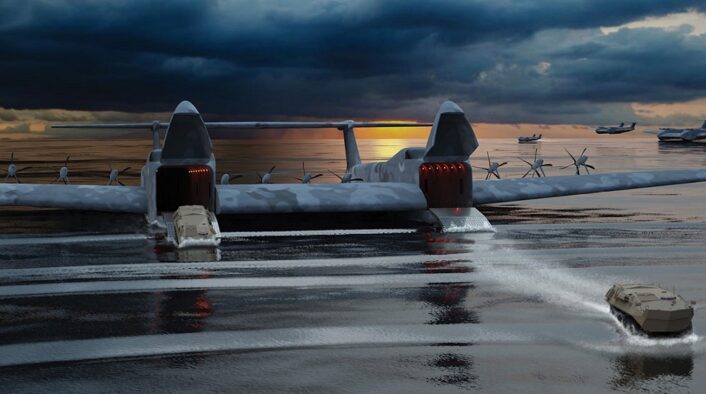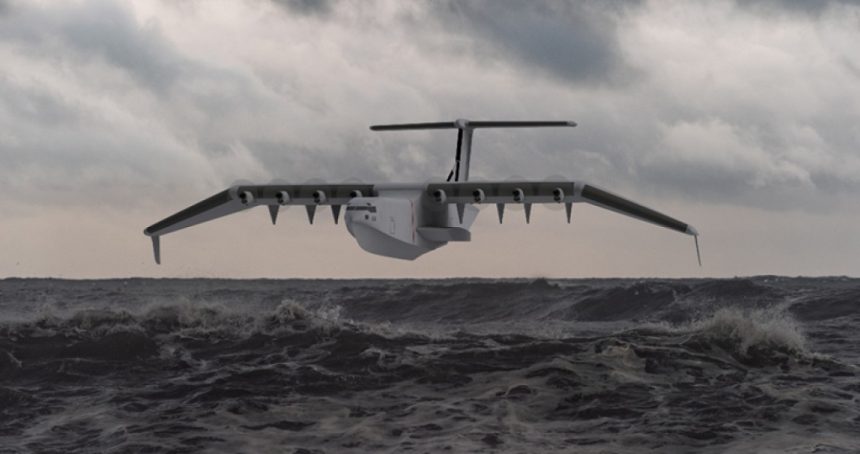The new X-plane will be a large flying boat similar in size and capacity to the C-17.
The Defense Advanced Research Projects Agency is working on a new X-plane under the Liberty Lifter Seaplane Wing-in-Ground Effect full-scale demonstrator program. Two teams, General Atomics working with Maritime Applied Physics Corporation and Aurora Flight Sciences working with Gibbs & Cox and ReconCraft, have been selected to develop designs to create a long-range, low-cost X-Plane capable of seaborne strategic and tactical heavy lift, similar in size and capacity to the C-17 Globemaster III transport aircraft.
The aircraft needs to be able to takeoff and land in Sea State 4, operate efficiently at less than 100 feet above the surface for sustained on-water operation up to Sea State 5 (up to 13 ft wave height), fly out of ground effect at altitudes of up to 10,000 feet and transport huge payloads at speeds faster than current sea lift platforms. The ferry range required is greater than 6,500 nm, while the cargo capacity should be enough for two USMC Amphibious Combat Vehicles (ACV) or six twenty-foot container units.
The concept behind the aircraft reminds the famous Ekranoplan, used by the Soviet and Russian navies in the 80s and 90s. The Russian MD-160 Lun class ekranoplan, of which only one unit has been built, is a gigantic ground effect vehicle (GEV) designed in 1975, designed to attain sustained flight over a level surface (usually over the sea) by making use of ground effect, the aerodynamic interaction between the wings and the surface.
While there are some similarities, there are a couple of big differences between the Ekranoplan and Liberty Lifter. The first is that the Ekranoplan is classified as maritime ship by the International Maritime Organization due to its use of the ground effect and the inability to operate out of ground effect. The second difference is the role, as the Ekranoplan was designed for anti-surface warfare and equipped with six P-270 Moskit antiship missile launchers, while Liberty Lifter is being designed for cargo operations.
“We are excited to kick off this program and looking forward to working closely with both performer teams as they mature their point-of-departure design concepts through Phase 1,” said DARPA Liberty Lifter Program Manager Christopher Kent. “The two teams have taken distinctly different design approaches that will enable us to explore a relatively large design space during Phase 1.”
During Phase 1, DARPA will work with both teams and Department of Defense to refine the Liberty Lifter designs with particular attention to operational needs and operating concepts. The Phase 1 contract awards are for an 18-month period of performance with six months of conceptual design work and nine months of design maturation culminating in a preliminary design review. There will be an additional three months for manufacturing planning and test/demonstration planning reviews.
The General Atomics team has selected a twin-hull, mid-wing design to optimize on-water stability and seakeeping, says the press release. It employs distributed propulsion using twelve turboshaft engines. The aircraft is depicted with a lifting nose section, similarly to the C-5 Galaxy, and a ramp to quickly unload the cargo.

“GA-ASI is committed to the advancement of a cargo seaplane design capable of delivering heavy cargo and utilizing Wing-in-Ground effect to revolutionize transport to support tomorrow’s warfighter,” said GA-ASI President David R. Alexander. “Our experience in maritime aircraft such as the MQ-9B SkyGuardian and SeaGuardian will help advance the capabilities of the Liberty Lifter concept and expand our cargo aircraft portfolio.”
Aurora Flight Sciences point-of-departure design more closely resembles a traditional flying boat, with a single hull, high wing and eight turboprops for primary propulsion. The wing has anhedral sections, which go downward just after the engines and seem to reach the waterline, with tips that might act as winglets in the air and fins in the water.
Aurora says the seaplane is designed for affordable full-scale production and extended maritime operations, including at high sea states and in high-traffic areas. The concept will employ a robust and adaptive control system designed to meet the challenge of operations to and from the sea surface and at low altitude around waves and obstacles.
“Developing an X-plane requiring innovative solutions and complex controls is at the core of Aurora’s expertise,” said Graham Drozeski, vice president of government programs at Aurora Flight Sciences. “We look forward to solving this challenge and providing a new strategic capability to support tomorrow’s warfighter.”

Both companies said the contract they have been awarded covers the first six months as the base effort for the conceptual design work and, if the options are exercised, they will go on with the remaining twelve months of the expected 18-month effort. Phase 1 will then transition into Phase 2 in mid-2024 with continued detailed design, manufacturing, and demonstration of a full-scale Liberty Lifter X-Plane. DARPA anticipates teaming with one or more DoD Service and international partners for those activities and further development of the Liberty Lifter concept into an operational vehicle.
The Liberty Lifter program is just a small part of the broader effort of the US military to extend its reach, expanding its aviation assets’ runway independence and expeditionary capability as national strategic objectives shift focus to littoral regions. Among the initiatives in this effort is the MC-130J Commando II Amphibious Capability (MAC) to improve the platform’s support of seaborne special operations.
MAC is being developed by the Air Force Special Operations Command in partnership with the Air Force Research Lab’s Strategic Development Planning and Experimentation (AFRL-SDPE) directorate. “The C-130J is an incredibly versatile aircraft, it’s landed on rough fields, in arctic locations and even an aircraft carrier,” said AFSOC when the program was first announced. “Yet, it cannot land on water, which covers about 71% of the planet. As, Air Force Special Operations Command is advancing new approaches to expand the multi-mission platform’s.”
AFSOC is testing MAC prototypes through digital design, virtual reality modeling (VR), and computer-aided designs (CAD) in a virtual setting known as the Digital Proving Ground (DPG), paving the way for digital simulation, testing, and the use of advanced manufacturing for rapid prototyping and physical prototype testing.
A demonstration of the removable amphibious float modification installed on the MC-130J was originally planned by the end of 2022, according to AFSOC statements in 2021. The demonstration was then moved to 2023, but now is seems it might have been pushed forward again and is not likely to happen by the end of the year.









